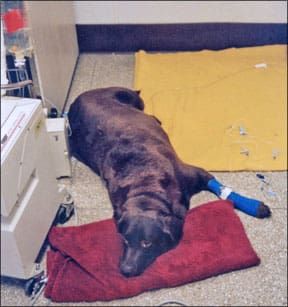Although I have received Whole Dog Journal for at least three years, I was thinking of letting my subscription lapse until I heard the terrible news of the dog food recall. If it wasnt for your newsletter I would still be feeding a terrible canned dog food (that I thought was high quality) to my two dogs. Needless to say my renewal is in the mail. I realize that this can happen to any dog food but I hope that the companies who care enough to use the best ingredients are also vigilant about safety. Please keep educating us on what to look for in dog food.
Mary Wright
Latrobe, PA
Thanks, Mary, for your continued support of Whole Dog Journal. Long-time readers know how much we, too, have learned about the industry over the 10 years Whole Dog Journal has been in print. Our goal is to continue to dig for new and ever-more-helpful information about the best canine diets.
We received many letters similar to the one below, but inquiring about different pet food companies.
I have a question regarding the food made by Timberwolf Organics. I currently feed this food (the bison/salmon variety) to my two dogs, and in light of recent events with the toxic dog food scare, I wanted to find out who manufactured it. I realize it is not involved in the recall; I just wanted to know.
Timberwolf Organics website says that due to proprietary/legal reasons they do not give out the name of their manufacturer.
Do you know who manufactures this food, and do you think it odd that they will not say who makes their products?
I dont know who manufactures that food (although I may have known at one time), and no, its not odd that they wont say where their products are made. I should say that its not odd, but its not right, either (in my humble opinion).
Weve long stated our preference for foods from companies that are willing to disclose detailed information about their products. A few years ago, that was a short list to choose from. Today, disclosure about manufacturing and even ingredient sourcing is becoming common enough to provide you with plenty of top-quality alternatives.
I have been contacting companies to see if they have products made by Menu Foods. There are a lot of us who dont want anything to do with this company, whether our foods were made at the plant that made the contaminated foods or another plant owned by Menu.
It would be nice to have a list of where the dog foods are actually made. Can you help compile a list?
I think this information should be listed on the label.
Thats funny; I was just thinking how helpful it would be if the manufacturer was listed on food labels alongside the (legally required) information for the company that sells the food.
I just made a snap decision. Given that we have long recommended that owners choose foods from companies that disclose their site (or sites) of manufacture, Im going to start including the site (or sites) of manufacture for all the products on Whole Dog Journals top foods lists. If a company wont disclose this information, its products wont appear on our lists.
Heres the thing: as I stated in Should You Boycott (Fill In the Blank)? on page 6 of this issue, I dont think its all that useful to boycott a pet food company, a contract manufacturer, or (especially) all the products made by a contract manufacturer following a single adverse event. Stuff happens, and even though the scale of this event was huge, and the injuries caused are horrific, its unlikely that it will ever be repeated. Of course, if Menu ever did have another deadly problem with its ingredients, Id join the protesters.
After the recent recall of some foods manufactured by Menu Foods, I have been very surprised to learn that some of the holistic brands on your top wet foods list are made by Menu, even if they are not part of the recall.
Why do these companies outsource the manufacturing of their foods to Menu Foods? How are we supposed to trust these brands if they have their foods manufactured in the same plants as low-quality foods? What about contamination?
How can we verify that all ingredients are originated in the U.S., not in China or elsewhere?
Do you intend to do an investigation on the origin of ingredients in foods? It would be a good idea to list all the brands that are manufactured in the U.S., with only American ingredients.
Judith Cassidy
Howell, Michigan
Thanks for your great questions.
First: Did I know that many of Whole Dog Journals top wet foods were made by Menu? Yes.
Why do companies with good products use Menu, which also produces some really low-quality foods? Because Menu is the largest contract manufacturer of wet pet foods in the U.S. No other co-packer has anything close to its capacity. And there are very few other options for the pet food companies that are large enough to need a high-capacity plant, but too small to be able to afford to buy or build a canning plant from scratch. Also, prior to this event, Menu had a very good reputation for the quality and reliability of its work.
What about contamination? Some companies source their own ingredients (or some of their ingredients). Most take advantage of Menus massive buying power to procure supplies of other ingredients at a lower cost. The companies should be well aware of the quality of the ingredients sourced by Menu, however; specifications for each ingredient are generally spelled out in their contract with the co-packer. If a company wants (and pays for) only the best-quality ingredients in its foods, Menu can supply them. If the pet food company wants to provide Menu with ingredients it has sourced independently, Menu can deal with that, too. Pet food executives trust Menu to keep these ingredients straight largely thanks to Menus long-term reputation for doing so.
As far as disclosing information about the source of the ingredients used in the products it makes for other companies Menu is contractually prohibited from doing so. Pet food companies and co-packers routinely sign nondisclosure agreements, in order to protect the pet food companies trade secrets. If the source of the ingredients in your dogs food is important to you, ask the company whose name is on the label for information. If you are not satisfied with their answers, move on.
Finally, I will write an article about the global market for pet food ingredients in an upcoming issue. Thanks for an excellent suggestion!
I know the pet food contamination story has been beaten to death, yet new facts keep coming to light, and I still have questions, such as:

288
Why would a (Canadian) company located in the middle of the American wheat belt (Kansas) buy wheat products that have to be shipped half way around the world? It is not like we dont have enough wheat of our own; why are we buying wheat from China? And how many dogs and cats in China have been killed by that product? Come to think of it, how many people in China die from contaminated food? We will never know.
I have always made an effort to buy pet food made in the USA; it isnt difficult. However, it is difficult to buy treats that are made in the U.S. Nine out of ten treat products are made in Asia or South America. I avoid them on the theory that the lax manufacturing oversight in the U.S. is better than no oversight at all.
It appears that I am going to have to rethink my criteria for food, and buy food with all its ingredients grown and processed in the USA. I hereby challenge all companies claiming to make a top tier food to meet that challenge and say on the bag that the ingredients are 100 percent North American-sourced and -processed. I would be glad to vote with my pet food dollars.
Mike Burks
via e-mail
Weve learned that wheat gluten from China costs about 10 cents less per pound than U.S.-grown and -processed wheat gluten, which costs around 60 cents per pound. Multiply that by the 792 metric tons of wheat gluten imported in the same lot as the contaminated product bought by Menu, and you begin to understand the size of the problem. I dont know how much of this wheat gluten Menu bought, but I do know that its very difficult for companies to take a pass on savings of that magnitude.
Of course, weve also now seen what the hidden price of a bargain ingredient may be.
Using U.S.-grown and -processed sources of ingredients that are abundant here makes sense.
I just read Mary Straus first article on feeding home-prepared diets to dogs. Although she is preaching to the converted with regard to me, I am still delighted to know that we will be getting the benefit of her excellent research and expertise. I have great respect for Mary, having read many of her articles in various media, and Im eagerly looking forward to the rest of the series.
I am getting a new GSD puppy in three weeks and having never fed a pup a home-prepared diet (although my last dog was fed a raw diet for eight years). Im relieved that I will have Mary to advise me on the best way to proceed.
Whole Dog Journal is the best thing to ever happen to those of us who care about the health and mental well-being of our dogs. (Ive also purchased Pat Millers book on positive dog training. Her training articles are excellent.)
Carol Marsh
Kanata, Ontario
Why cant Whole Dog Journal list all of its top foods on its website for all dog owners to benefit from? I contacted your customer service department and was told I would have to pay for a subscription or a back issue if I wanted that information. Im looking for safe foods. Clearly you care more about profits than saving the lives of dogs. I will never subscribe and support a company that puts its profits before anyone else. Besides, I found the information on a website for free.
Wow.
First, because we do not sell advertising, we must charge for our content. If we gave it away, we wouldnt be able to pay our contributors, printer, etc., and we wouldnt be able to continue to research and analyze the pet food industry (and other canine-health-related industries).
Yes, our publisher is a for-profit company, and we expect to be paid for expert analysis. We dont think that makes us puppy killers. You must value what we have to say, or you wouldnt be driven to search for a free way to access it! We would think your peace of mind would be worth the price of a subscription.





